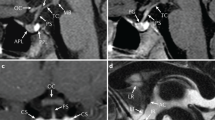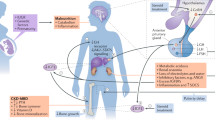Abstract
Children with Hurler syndrome experience progressive growth failure after hematopoietic cell transplantation (HCT). The goal of this study was to review the safety and efficacy of growth hormone (GH) in eight children with Hurler syndrome who were treated at our institution with GH for short stature or GH deficiency between 2005 and 2008. The age at initiation of treatment with GH was 9.6±2.3 years and time since HCT was 7.5±1.5 years. Mean GH dose was 0.32 mg/kg/week. Baseline growth velocity was 3.5±1.5 cm/year (−2.6±1.9 s.d.), and it increased to 5.2±3.0 cm/year (−0.1±3.6 s.d.) after 1 year of treatment. Of the six patients with radiographic data, there was one progression of scoliosis, one progression of kyphosis and one progression of genu valgum. No patient discontinued treatment due to progression of skeletal disease. One patient discontinued GH due to slipped capital femoral epiphysis. Preliminary data suggest that 1-year GH treatment may modestly improve growth velocity in children with Hurler syndrome.
This is a preview of subscription content, access via your institution
Access options
Subscribe to this journal
Receive 12 print issues and online access
$259.00 per year
only $21.58 per issue
Buy this article
- Purchase on Springer Link
- Instant access to full article PDF
Prices may be subject to local taxes which are calculated during checkout


Similar content being viewed by others
References
Bach G, Friedman R, Weissmann B, Neufeld EF . The defect in the Hurler and Scheie syndromes: deficiency of -L-iduronidase. Proc Natl Acad Sci USA 1972; 69: 2048–2051.
Neufeld E, Munezer I. The Metabolic & Molecular Basis of Inherited Disease. 8 edn. McGraw-Hill: New York, 2001, pp 3421–3452.
Polgreen L, Plog M, Tolar J, Himes JH, Orchard P, Whitley C et al. Growth and endocrine function in patients with Hurler syndrome after hematopoietic stem cell transplantation. Bone Marrow Transplant 2008; 41: 1005–1011.
Russell C, Hendson G, Jevon G, Matlock T, Yu J, Aklujkar M et al. Murine MPS I: insights into the pathogenesis of Hurler syndrome. Clin Genet 1998; 53: 349–361.
Silveri CP, Kaplan FS, Fallon MD, Bayever E, August CS . Hurler syndrome with special reference to histologic abnormalities of the growth plate. Clin Orthop Relat Res 1991, 305–311.
Dusing SC, Thorpe D, Rosenberg A, Mercer V, Escolar ML . Gross motor abilities in children with Hurler syndrome. Dev Med Child Neurol 2006; 48: 927–930.
Ashworth JL, Biswas S, Wraith E, Lloyd IC . The ocular features of the mucopolysaccharidoses. Eye 2006; 20: 553–563.
Krivit W . Allogeneic stem cell transplantation for the treatment of lysosomal and peroxisomal metabolic diseases. Springer Semin Immunopathol 2004; 26: 119–132.
Staba SL, Escolar ML, Poe M, Kim Y, Martin PL, Szabolcs P et al. Cord-blood transplants from unrelated donors in patients with Hurler's syndrome. N Engl J Med 2004; 350: 1960–1969.
Vellodi A, Young EP, Cooper A, Wraith JE, Winchester B, Meaney C et al. Bone marrow transplantation for mucopolysaccharidosis type I: experience of two British centres. Arch Dis Child 1997; 76: 92–99.
Tolar J, Grewal SS, Bjoraker KJ, Whitley CB, Shapiro EG, Charnas L et al. Combination of enzyme replacement and hematopoietic stem cell transplantation as therapy for Hurler syndrome. Bone Marrow Transplant 2008; 41: 531–535.
Cox-Brinkman J, Boelens JJ, Wraith JE, O′Meara A, Veys P, Wijburg FA et al. Haematopoietic cell transplantation (HCT) in combination with enzyme replacement therapy (ERT) in patients with Hurler syndrome. Bone Marrow Transplant 2006; 38: 17–21.
Grewal SS, Wynn R, Abdenur JE, Burton BK, Gharib M, Haase C et al. Safety and efficacy of enzyme replacement therapy in combination with hematopoietic stem cell transplantation in Hurler syndrome. Genet Med 2005; 7: 143–146.
Frisk P, Arvidson J, Gustafsson J, Lönnerholm G . Pubertal development and final height after autologous bone marrow transplantation for acute lymphoblastic leukemia. Bone Marrow Transplant 2004; 33: 205–210.
Shalitin S, Phillip M, Stein J, Goshen Y, Carmi D, Yaniv I . Endocrine dysfunction and parameters of the metabolic syndrome after bone marrow transplantation during childhood and adolescence. Bone Marrow Transplant 2006; 37: 1109–1117.
Perkins JL, Kunin-Batson AS, Youngren NM, Ness KK, Ulrich KJ, Hansen MJ et al. Long-term follow-up of children who underwent hematopoietic cell transplant (HCT) for AML or ALL at less than 3 years of age. Pediatr Blood Cancer 2007; 49: 958–963.
Bakker B, Massa GG, Oostdijk W, Van Weel-Sipman MH, Vossen JM, Wit JM . Pubertal development and growth after total-body irradiation and bone marrow transplantation for haematological malignancies. Eur J Pediatr 2000; 159: 31–37.
Couto-Silva AC, Trivin C, Esperou H, Michon J, Baruchel A, Lemaire P et al. Final height and gonad function after total body irradiation during childhood. Bone Marrow Transplant 2006; 38: 427–432.
Legault L, Bonny Y . Endocrine complications of bone marrow transplantation in children. Pediatr Transplant 1999; 3: 60–66.
Shankar SM, Bunin NJ, Moshang Jr T, Jr . Growth in children undergoing bone marrow transplantation after busulfan and cyclophosphamide conditioning. J Pediatr Hematol Oncol 1996; 18: 362–366.
Bakker B, Oostdijk W, Bresters D, Walenkamp MJ, Vossen JM, Wit JM . Disturbances of growth and endocrine function after busulphan-based conditioning for haematopoietic stem cell transplantation during infancy and childhood. Bone Marrow Transplant 2004; 33: 1049–1056.
Huma Z, Boulad F, Black P, Heller G, Sklar C . Growth in children after bone marrow transplantation for acute leukemia. Blood 1995; 86: 819–824.
Weisstein JS, Delgado E, Steinbach LS, Hart K, Packman S . Musculoskeletal manifestations of Hurler syndrome: long-term follow-up after bone marrow transplantation. J Pediatr Orthop 2004; 24: 97–101.
Field RE, Buchanan JA, Copplemans MG, Aichroth PM . Bone-marrow transplantation in Hurler′s syndrome. Effect on skeletal development. J Bone Joint Surg Br 1994; 76: 975–981.
Khanna G, Van Heest AE, Agel J, Bjoraker K, Grewal S, Abel S et al. Analysis of factors affecting development of carpal tunnel syndrome in patients with Hurler syndrome after hematopoietic cell transplantation. Bone Marrow Transplant 2007; 39: 331–334.
Cave CB, Bryant J, Milne R . Recombinant growth hormone in children and adolescents with Turner syndrome. Cochrane Database Syst Rev 2003, CD003887.
Lanes R, Carrillo E . Long-term therapy with a single daily subcutaneous dose of growth hormone releasing hormone (1–29) in prepubertal growth hormone deficient children. Venezuelan Collaborative Study Group. J Pediatr Endocrinol 1994; 7: 303–308.
Rosenbloom AL, Knuth C, Shulman D . Growth hormone by daily injection in patients previously treated for growth hormone deficiency. South Med J 1990; 83: 653–655.
Polgreen L, Steiner M, Dietz CA, Manivel JC, Petryk A . Thymic hyperplasia in a child treated with growth hormone. Growth Horm IGF Res 2007; 17: 41–46.
Consensus guidelines for the diagnosis treatment of growth hormone (GH) deficiency in childhood adolescence: summary statement of the GH Research Society GH Research Society. J Clin Endocrinol Metab 2000; 85: 3990–3993.
Wilson TA, Rose SR, Cohen P, Rogol AD, Backeljauw P, Brown R et al. Update of guidelines for the use of growth hormone in children: the Lawson Wilkins Pediatric Endocrinology Society Drug and Therapeutics Committee. J Pediatr 2003; 143: 415–421.
Wang E, Drummond D, Dormans J, Moshang T, Davidson R, Gruccio D . Scoliosis in patients treated with growth hormone. J Pediatr Orthop 1997; 17: 708–711.
Day G, McPhee I, Batch J, Tomlinson F . Growth rates and the prevalence and progression of scoliosis in short-statured children on Australian growth hormone treatment programmes. Scoliosis 2007; 2: 1–8.
Quigley C, Gill A, Crowe B, Robling K, Chipman J, Rose S et al. Safety of growth hormone treatment in pediatric patients with idiopathic short stature. J Clin Endocrinol Metab 2005; 90: 5188–5196.
Vidil A, Journeau P, Soulie A, Padovani J, Pouliquen J . Evolution of scoliosis in six children treated with growth hormone. J Pediatr Orthop B 2001; 10: 197–200.
Bolar K, Hoffman AR, Maneatis T, Lippe B . Long-term safety of recombinant human growth hormone in Turner syndrome. J Clin Endocrinol Metab 2008; 93: 344–351.
Nagai T, Obata K, Obata T, Murakami N, Katada Y, Yoshino A et al. Growth hormone therapy and scoliosis in patients with Prader–Willi syndrome. Am J Med Genet A 2006; 140A: 1623–1627.
Nishi Y, Tanaka T, Fujieda K, Hanew K, Hirano T, Igarashi Y et al. Slipped capital femoral epiphysis, Perthes’ disease and scoliosis in children with growth hormone deficiency. Endocr J 1998; 45 (Suppl): S167–S169.
Blethen SL, Rundle AC . Slipped capital femoral epiphysis in children treated with growth hormone. Horm Res 1996; 46: 113–116.
Maneatis T, Baptista J, Connelly K, Blethen S . Growth hormone safety update from the National Cooperative Growth Study. J Pediatr Endocrinol Metab 2000; 13: 1035–1044.
Rappaport E, Fife D . Slipped capital femoral epiphysis in growth-hormone deficient patients. Am J Dis Child 1985; 139: 396–399.
Exner G . Growth and pubertal development in slipped capital femoral epiphysis: a longitudinal study. J Pediatr Orthop 1986; 6: 403–409.
Giorgiani G, Bozzola M, Locatelli F, Picco P, Zecca M, Cisternino M et al. Role of busulfan and total body irradiation on growth of prepubertal children receiving bone marrow transplantation and results of treatment with recombinant human growth hormone. Blood 1995; 86: 825–831.
Acknowledgements
We would like to recognize Dr William Krivit for his pioneering work in the field of transplant for MPS IH. We would also like to thank the outstanding nurses who have cared for these patients over the years, Eileen Hanson and Teresa Kivisto for their dedication in the care of the families and in obtaining the necessary data, and the support of the families in furthering our understanding of MPS IH. This study was partially funded by the Children's Cancer Research Fund, Minneapolis, MN (JT and PJO), NIH T32-DK065519 (LEP), and the Minnesota Medical Foundation (JT and MP).
Author information
Authors and Affiliations
Corresponding author
Rights and permissions
About this article
Cite this article
Polgreen, L., Plog, M., Schwender, J. et al. Short-term growth hormone treatment in children with Hurler syndrome after hematopoietic cell transplantation. Bone Marrow Transplant 44, 279–285 (2009). https://doi.org/10.1038/bmt.2009.31
Received:
Revised:
Accepted:
Published:
Issue Date:
DOI: https://doi.org/10.1038/bmt.2009.31
Keywords
This article is cited by
-
The use of recombinant human growth hormone in patients with Mucopolysaccharidoses and growth hormone deficiency: a case series
Italian Journal of Pediatrics (2019)
-
Treatment of thoracolumbar kyphosis in patients with mucopolysaccharidosis type I: results of an international consensus procedure
Orphanet Journal of Rare Diseases (2019)
-
Growth, final height and endocrine sequelae in a UK population of patients with Hurler syndrome (MPS1H)
Journal of Inherited Metabolic Disease (2011)
-
Orthopaedic management of Hurler's disease after hematopoietic stem cell transplantation: a systematic review
Journal of Inherited Metabolic Disease (2011)
-
Mucopolysaccharidosis type II: European recommendations for the diagnosis and multidisciplinary management of a rare disease
Orphanet Journal of Rare Diseases (2011)



